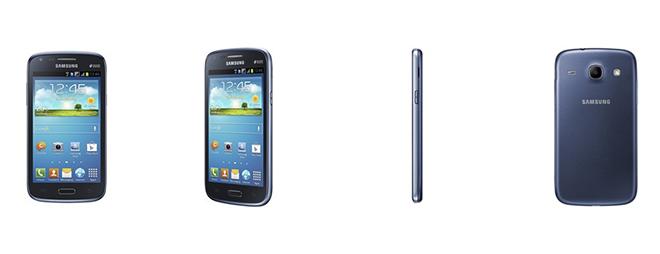Chief Apple rival Samsung is leaving no corner of the smartphone market unaddressed, as the tech giant revealed on Monday the Galaxy Core, which packs many of the features of its high end model into a lower-cost handset.
The new handset retains many of the design cues of Samsung's recently released Galaxy S4 flagship smartphone. Like the S4, the Core will have software features allowing users control the device without touching it, pause video by looking away, and keep the device active by looking at it.
Inside, the Galaxy Core will pack a 1.2GHz dual-core processor running Android 4.1 Jelly Bean on 1GB of RAM. Available in one option with 8GB of storage, the Core has a 4.3-inch WVGA LCD display outputting at 480x800, a VGA front-facing camera, and a 5MP main camera with LED flash. Buyers will have the option of a single or dual-SIM model.
Compared against a number of other Samsung models, the Core is decidedly low-end, but it is in keeping with Samsung's strategy of unleashing a barrage of devices and grabbing as much of every aspect of the smartphone market as possible. That strategy allows the South Korean conglomerate to hit virtually every price point on the spectrum, with offerings ranging from lower-end models through to the premium-end Galaxy S4, as well as niche models like the Galaxy Note 2.
This scattershot approach to addressing the market has helped make Samsung the number one smartphone manufacturer in terms of overall units sold, with 69.4 million handsets sold last quarter. Apple with its iPhone beat Samsung in terms of profit, but the South Korean giant has been gradually gaining on Apple in that respect as well.
Between the two, Samsung and Apple snatched up all of the profit in the smartphone segment for the quarter.
The Core will likely be followed by an assortment of other low-end Samsung models, as the company tailors its offerings to seemingly niche categories across the world. The low-cost Galaxy, though, highlights a key difference between Apple and Samsung.
Whereas Samsung releases dozens of phone models per year, Apple does only one each year so far. Where Samsung makes whole new models to hit certain price points, Apple releases a phone and simply turns its two predecessors into its "low-cost" models.
That strategy has largely paid off for Apple, as the iPhone 5 and iPhone 4S were the most popular handsets in the world in the fourth quarter of 2012. The California-based manufacturer, though, still faces continuing calls from analysts and observers for a lower-cost iPhone, thought to be necessary due to the apparent maturation of much of the premium smartphone market.
Apple is thought to be working on just such a handset in order to address developing markets such as China, Brazil, and India, where its iPhone, while desired, is simply priced out of the range of most consumers.
Apple may be working on just such a unit, if recent rumors are to be believed. Reports and supposedly leaked components point to a polycarbonate-backed device that would allow the company to save money on components even as it takes on the low-cost segment.
 AppleInsider Staff
AppleInsider Staff







-m.jpg)






 Charles Martin
Charles Martin

 Malcolm Owen
Malcolm Owen
 William Gallagher
William Gallagher

 Christine McKee
Christine McKee
 Wesley Hilliard
Wesley Hilliard








33 Comments
Wait, 8 GB of storage? With all the software features of the S4? Weren't these software features cited as the reason why the 16 GB S4 has less than 8 GB free?
Hmmmmm, will be interesting to see how much of the 8GB remains when new.
Hmmmmm, will be interesting to see how much of the 8GB remains when new.
Not really an issue since it has a microSD slot.
Apparently it will also come in a dual-SIM version, which is popular in many parts of the world.
My question is: what's the target price? Has that been mentioned?
Apple may be working on just such a unit, if recent rumors are to be believed. Reports and supposedly leaked components point to a polycarbonate-backed device that would allow the company to save money on components even as it takes on the low-cost segment.
I think the polycarbonate back makes sense for a lower cost iPhone. Not because it is a cheaper component but because a less expensive iPhone would be targeted at lower income individuals who likely have more physical labor type employment so the phone would perhaps be more durable in the front jeans pocket than the 4S which has the glass back. Also, another possible target demographic might be teenagers who have never been known to take very good care of their stuff so again, a more durable iPhone is a plus.
Not really an issue since it has a microSD slot.
Nope! Not an issue that you can't put apps anywhere but the phone!